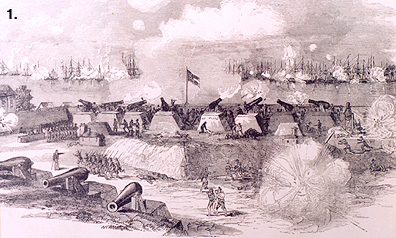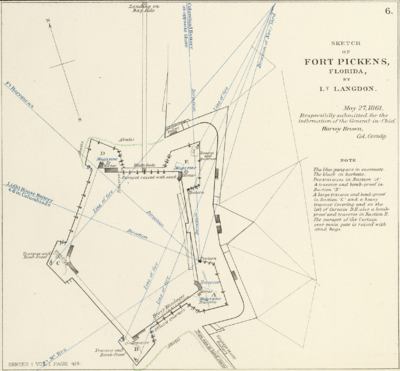 |
| Flag Officer Du Pont, Union Naval Commander |
As we have
discussed before, a part of the Union's plan to win the war was through a blockade of the South. But one problem that they faced was the need to resupply their coal burning ships. They decided to attack Port Royal, near Hilton Head, South Carolina since it was close to both Charleston and Savannah.
 |
| Map of Port Royal |
To defend the port, the Confederates had constructed two forts on opposite sides of the bay. Beauregard, who drew up the plans, recommended against building them because they were too far from each other to provide support. Fort Wagner and Fort Beauregard each contained 13 guns, mostly of a small caliber in a water battery, and ten and six respectively to guard against land attack. They had over 3,000 troops to defend these positions. There were also four small gun boats available, but they were too weak to stand up to the Federal warships.
For the attack on Port Royal the North assembled what was, up to that point, the largest fleet to sail under the American flag, with 19 warships and 68 other ships. On the way to Port Royal, on November 1, the fleet was struck with a storm. The fleet was scattered and four ships were sunk. By November 4 the fleet was reassembled, except for a few ships which had to return home for repairs. Some naval skirmishing occurred on November 4 and 5, which showed that the Confederate gunboats would do little in the face of the powerful Federal vessels. The Union army commander also informed the fleet commander that the army could not participate in the attack because the lost ships contained necessary ammunition. Flag Officer Du Pont, the fleet commander, decided to go on with the naval attack. The battle was delayed until November 7th because of bad weather. Du Pont decided to go with a strategy similar to that used at the Battle of Hatteras Inlets. He would have his ships bombard while moving, hoping to thus avoid the forts' fire.
 |
| Bombarding Port Royal |
As the Union fleet opened fire on the forts at around 9:30 AM, the plan quickly fell apart as the ships fell out of line to get better shots. They had found a position to be able to fire on Fort Walker without the defenders being able to put up an effective return fire. All but three of its water facing guns were disabled, and the Confederates began to abandon the fort. The Union fleet seeing this, ceased fire and occupied the fort. The garrison was allowed to escape unpursued. The commander of Fort Beauregard, although his command had suffered much less damage, feared that his retreat would be cut off and ordered his men to retreat. They were undetected, and were able to escape although their stores fell into Union hands.
 |
| Confederate Fort Receiving the Union Fire |
The casualties were relatively light in this battle, with 11 Confederates dead and 47 wounded, and with the Union fleet having 8 killed and 23 wounded. Although this battle has largely been forgotten, it had an important effect on the flow of the war. A Union author wrote:
The Battle of Port Royal Bay has been somewhat overshadowed by the later naval victories of the war, but at the same time it was admirably planned and brilliantly executed. It was a battle in which ships engaged and captured forts on shore which were supposed to be impregnable to attack from the sea, for the army remained on board its transports and took no hand in the fighting, not landing until the forts had been abandoned under the fire of the naval guns. It had a good moral effect, for it came at a time when the Confederate arms had been generally successful and the feeling of despondency at the North was widespread, and this effect was felt abroad as well as at home. The object for which the expedition set out had been perfectly successful, and the plan carried out in its entirety, without hitch or mistake.1
1. Biographical Memoirs (Washington City: National Academy of Sciences, 1895), vol. III, p. 36






















